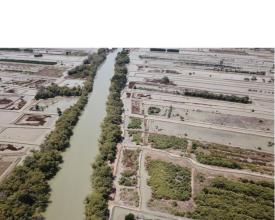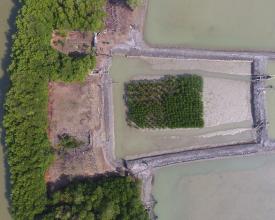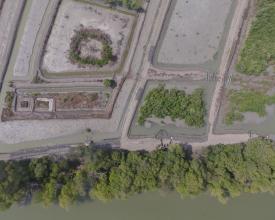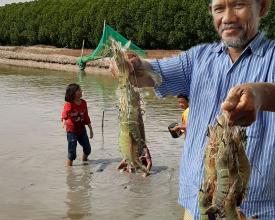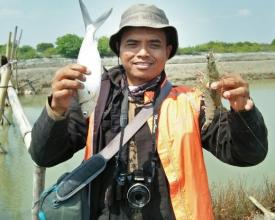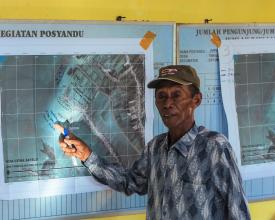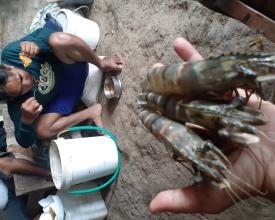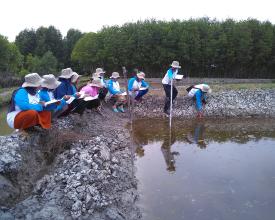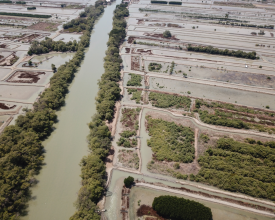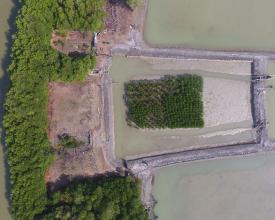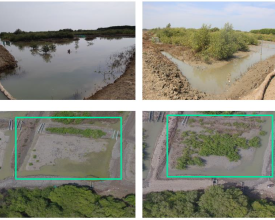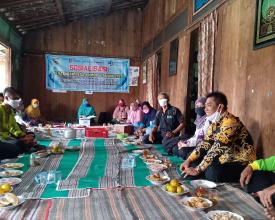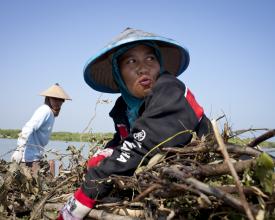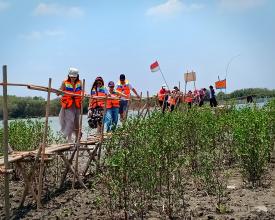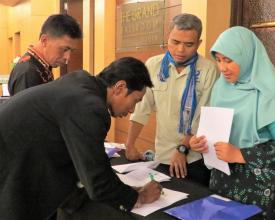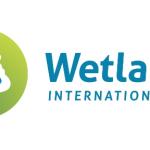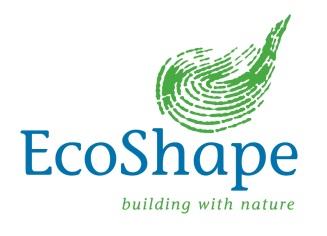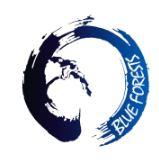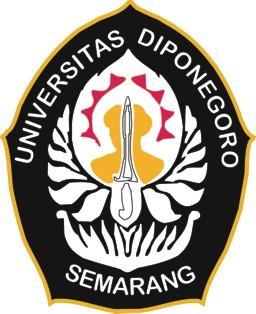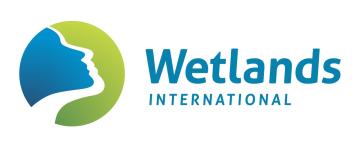
Aquaculture associée à la mangrove
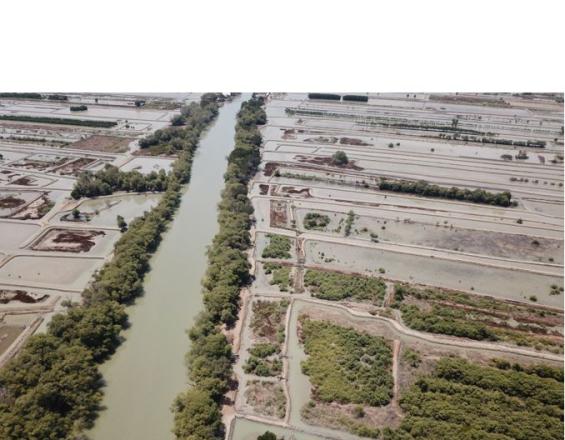
L'expansion de l'aquaculture des crevettes a entraîné la disparition des mangroves dans le monde entier, rendant les deltas et les côtes tropicales vulnérables à l'érosion, aux inondations et à la perte de terres, réduisant ainsi les possibilités de subsistance des populations côtières. Dans le district de Demak, au centre de Java, en Indonésie, nous avons introduit les systèmes d'aquaculture associée à la mangrove (AMA). Il a été demandé aux agriculteurs d'abandonner une partie de leur étang d'aquaculture en construisant une nouvelle digue avec de nouvelles portes tout en créant un espace en pente pour une ceinture verte de mangrove riveraine. Pour susciter la volonté et la capacité, les éleveurs de crevettes locaux ont été formés sur le tas dans le cadre d'écoles de terrain côtier qui ont encouragé les pratiques aquacoles respectueuses de l'environnement et ont permis d'augmenter leurs revenus. La première année, une centaine d'éleveurs de Demak ont converti environ 10 % de leurs 104 ha d'étangs en habitat de mangrove, où les sédiments se déposent et où les mangroves se développent (repoussent ?) naturellement en l'espace d'un an.
Contexte
Défis à relever
Le premier défi, la volonté des agriculteurs de réduire la taille des étangs, a été relevé grâce à l'augmentation des rendements et des revenus après la formation à l'école de terrain. Le deuxième défi, à savoir un capital suffisant pour la construction de la nouvelle digue et des vannes, a été relevé grâce à une subvention de Bio-Rights (voir le bloc de construction Bio-Rights). Pour le troisième défi, la mise en œuvre technique, nous avons préparé des lignes directrices, organisé une formation pour les travailleurs sur le terrain et conduit des ateliers pratiques pour les agriculteurs participants dans chaque communauté. Le quatrième défi concerne l'enlèvement de l'ancienne digue, qui peut entraîner la perte de droits fonciers et l'exposition des digues ( ?) des étangs voisins. Dans un premier temps, les agriculteurs ont ouvert les vannes des anciennes digues plus fréquemment ou de manière permanente ; lorsque tous les étangs situés le long d'une voie d'eau sont convertis en systèmes associés de mangrove et que la communauté a statué sur les droits de propriété, les agriculteurs peuvent cesser d'entretenir les anciennes digues ou les enlever.
Emplacement
Traiter
Résumé du processus
Le CSA a permis de faire connaître l'importance de la mangrove et de renforcer la capacité des agriculteurs à augmenter durablement leurs rendements et leurs revenus. Dans l'ensemble, cela leur a donné la volonté de contribuer au rétablissement de la ceinture verte, soit en abandonnant des étangs entiers, soit en construisant des AMA. Les contrats de bio-droits ont fourni à ces agriculteurs une compensation soit pour la perte de revenus, soit pour l'investissement dans la digue supplémentaire avec de nouvelles vannes d'eau. Ces derniers étaient organisés, comme traditionnellement, en groupes qui s'entraidaient. (Je ne comprends pas cette phrase. Est-elle nécessaire ?)
Ainsi, ces agriculteurs pauvres en ressources ont reçu la capacité humaine, sociale et financière de transformer leur système de production aquacole et de contribuer à la récupération des ceintures vertes riveraines en faisant une AMA de leurs étangs. Comme les pêcheurs bénéficient de meilleures prises, ils soutiennent l'innovation au niveau communautaire, attribuent un budget à la restauration de la ceinture verte et statuent sur les droits de propriété ou d'utilisation des produits de la mangrove.
Blocs de construction
Écoles de terrain sur le littoral
La plupart des aquaculteurs indonésiens obtiennent de faibles rendements ou bénéfices en raison d'une formation insuffisante, de mauvaises pratiques et de l'utilisation de produits chimiques et d'antibiotiques qui perturbent l'équilibre écologique. Le CFS est un processus d'apprentissage qui renforce les capacités des petits aquaculteurs locaux et forme de petits groupes aux bonnes pratiques. Au cours d'un cycle de production (12 à 16 sessions), les agriculteurs apprennent l'écologie des étangs, la gestion des étangs au moyen d'une aquaculture durable à faible apport externe (LEISA) et l'écologie des eaux côtières, y compris les fonctions des ceintures vertes de mangrove (sensibilisation à la réhabilitation des mangroves). Les agriculteurs étudient l'agroécosystème, conçoivent des systèmes de production aquacole, observent des étangs de démonstration, synthétisent des données et débattent avec leurs collègues. Ils apprennent à fabriquer du compost liquide et sec pour soigner, fertiliser et gérer le sol et l'eau de leurs étangs. Enfin, ils prennent des décisions éclairées sur les prochaines étapes de la gestion des étangs. Grâce à ce processus, les participants peuvent déterminer la ou les nouvelles pratiques qu'ils peuvent appliquer immédiatement. Les agriculteurs acquièrent également une plus grande confiance dans la prise de décision et la prise de parole en public. Dans ce projet, après avoir terminé les programmes, les anciens élèves ont continué à s'engager dans des activités post-scolaires sur le terrain (telles que l'AMA et la pratique de formes d'aquaculture intégrée multitrophique pour les crevettes (IMTA)).
Facteurs favorables
- Le projet BwN Indonésie a été le premier à montrer que l'érosion côtière désastreuse pouvait être inversée grâce à des structures perméables, ce qui a créé un climat de confiance.
- Des personnes ressources ont complété le programme, ce qui a incité les agriculteurs à expérimenter de nouvelles techniques et de nouvelles espèces.
- Les tests préalables et postérieurs ont permis d'identifier et de traiter les problèmes en temps utile.
- Une réunion finale visant à identifier les activités de suivi a abouti à la création de plates-formes indépendantes d'agriculteurs qui continuent à expérimenter et à discuter de leurs apprentissages.
Leçon apprise
- À Demak, plus de 80 % des participants ont adopté LEISA dans une certaine mesure, et ces derniers ont triplé leurs marges brutes par rapport à la plupart des non-adoptants. Cela signifie que le coût de la formation a été récupéré en l'espace d'un an, ce qui fait du CSA l'une des interventions de formation rurale les plus efficaces. En outre, l'augmentation des revenus a encouragé les efforts de restauration des mangroves pour la sécurité côtière.
- Certains de ceux qui n'ont pas adopté LEISA ont été mis en relation avec d'autres projets offrant des semis gratuits de crevettes et de poissons laitiers à condition de suivre les directives du projet en matière d'aquaculture.
- Recruter 50 % de femmes a été un défi. Au cours de la dernière année, les formatrices du projet ont recruté des participants pour deux CSA axés sur les femmes, en incluant des femmes parmi les premiers adoptants en tant que co-facilitatrices.
- Après une formation au CSA, les agriculteurs continuent d'innover, par exemple en engraissant le crabe bleu et en devenant actifs dans les réseaux sociaux (d'apprentissage). Le CSA a un impact sur les moyens de subsistance des familles et des communautés.
Aquaculture de mangrove associée (AMA)
L'AMA associe l'aquaculture aux ceintures vertes de mangroves le long des côtes dans les estuaires. Les ceintures vertes sont inexistantes dans la plupart des fermes. Contrairement à la plupart des systèmes de sylvo-aquaculture où les mangroves sont plantées sur les digues et dans les étangs, dans l'AMA elles sont situées à l'extérieur de l'étang, où les mangroves contribuent à l'atténuation du climat. Les mangroves sur les digues et dans les étangs entravent l'entretien des étangs et leur litière et leur ombre réduisent la productivité. Les feuilles se décomposent dans les étangs, fournissant des sources d'alimentation aux crevettes et aux organismes cultivés. Cependant, l'excès de litière augmente les niveaux d'ammoniaque, diminue la teneur en oxygène dissous et réduit la productivité des étangs.
Dans l'AMA, la gestion de l'étang n'est pas entravée par les feuilles ou l'ombre, et bénéficie d'une meilleure qualité de l'eau entrante. Un seul agriculteur peut pratiquer l'AMA, mais dans l'idéal, tous les agriculteurs situés le long d'un canal améliorent le paysage. Comme les agriculteurs doivent renoncer à une partie de leur surface d'étang, qui représente un potentiel de production, ils sont compensés par une amélioration des rendements. Les bénéfices sont obtenus à partir de l'étang le plus petit, en appliquant les meilleures pratiques des écoles d'agriculture côtière.
Facteurs favorables
- Le CSA a montré aux exploitants d'étangs comment augmenter leurs rendements en utilisant LEISA et des étangs plus petits. Les agriculteurs de l'AMA ont pu stabiliser leurs revenus malgré des inondations extrêmes.
- L'AMA fournit aux agriculteurs des revenus supplémentaires grâce aux produits forestiers et à l'augmentation des captures dans leurs pièges, ainsi qu'à l'augmentation des captures de poissons.
- Sur l'île de Tanakeke (Sulawesi du Sud), les pisciculteurs qui cèdent tout ou partie de leurs étangs pour la reconstitution de la mangrove peuvent bénéficier d'un allègement fiscal (servitude de conservation).
Leçon apprise
- Les agriculteurs ont hésité à enlever l'ancienne digue qui borde la voie d'eau, car elle limite leur parcelle. Le fait de laisser les anciennes vannes ouvertes la plupart du temps a suffi à créer une nouvelle couche de sédiments de 10 cm par an et un afflux de jeunes plants pour la repousse naturelle de la mangrove.
- Le mécanisme de financement de Bio-Rights et la collaboration de groupe sont des mesures d'accompagnement essentielles pour recruter des agriculteurs pauvres.
- Lorsque la digue de l'étang fait l'objet d'une protection importante ou qu'elle supporte une grande route, son déplacement nécessite une planification au niveau du district et un investissement important.
- Les digues d'étang portant des routes carrossables peuvent être déplacées à l'unisson par les propriétaires voisins, même si cela nécessite une planification et engendre des coûts. Les digues comportant des sentiers pédestres ou des pistes cyclables peuvent être déplacées plus facilement.
- Les digues des étangs partagés avec des voisins qui ne veulent pas changer leur système devront être renforcées, car les variations du niveau de l'eau peuvent provoquer une érosion ou une pression inégale.
- L'étang restant doit avoir une largeur de 20 m ou plus. Les étangs plus étroits sont coûteux à transformer ou deviennent économiquement non viables. Nous conseillons une transformation complète en ceinture verte de mangrove.
Ressources
Bio-droits
De nombreux pauvres des zones rurales sont pris au piège de la pauvreté pour satisfaire leurs besoins de subsistance à court terme et sont contraints d'exploiter l'environnement naturel de manière non durable. Cette exploitation accroît leur vulnérabilité et limite encore davantage leurs possibilités de développement. C'est pourquoi, afin de concilier la productivité de l'aquaculture avec la conservation et la restauration des mangroves, nous avons introduit le mécanisme d'incitation financière Bio-rights à Demak. En échange d'un engagement actif dans les mesures de conservation et de restauration, les communautés ont reçu un soutien financier et technique pour développer des moyens de subsistance durables. Les accords de bio-droits sont conditionnels : les paiements aux communautés ne sont effectués qu'après une restauration réussie. L'approche couvre une partie des coûts auxquels les agriculteurs ou la communauté doivent faire face pour transformer leurs pratiques actuelles non durables (dégradation de la ceinture verte de mangroves dont ils dépendent pour leur sécurité côtière) en stratégies de subsistance durables à long terme. Cela les incite à s'intéresser à long terme à leur travail de conservation. Certains groupes communautaires mettent de côté une partie du capital dans un fonds d'épargne collectif.
Facteurs favorables
- Les groupes communautaires de 9 villages situés le long de la côte de Demak ont été soutenus par le personnel indonésien du consortium Building with Nature, qui a résidé dans le district de Demak pendant toute la durée du projet.
- Les communautés locales ont désigné des personnes pour participer aux programmes.
- Tous les groupes communautaires doivent être bien organisés et capables d'accéder aux fonds gouvernementaux, de les recevoir et de les gérer.
- L'approche des bio-droits repose sur la capacité et la sensibilisation des membres de la communauté ; ces deux éléments ont été renforcés par les écoles de terrain côtières.
Leçon apprise
- Auparavant, après la conversion des mangroves en étangs, les agriculteurs ne réfléchissaient pas aux liens entre leurs moyens de subsistance et les mangroves. Ils ont accepté passivement les inondations et la baisse des rendements de l'aquaculture et de la pêche.
- Après que le CSA ait suscité une prise de conscience, de la créativité et de la volonté, l'approche des bio-droits a été le dernier moyen d'inciter les communautés à consacrer des zones à la restauration des ceintures vertes.
- Des fonds ont été mis à la disposition des groupes communautaires en échange de la fourniture de "services écosystémiques" destinés à améliorer les moyens de subsistance, grâce à des "contrats globaux" fondés sur les bio-droits.
- Pour assurer un financement durable de la réhabilitation des mangroves, une partie des fonds peut être mise de côté dans un fonds d'épargne collectif et/ou utilisée pour des activités économiques rentables. À Demak, un village a lancé une promenade commerciale dans la mangrove ; d'autres ont acheté des machines pour préparer le compost (liquide) pour leurs étangs.
- En incluant la politique et le plaidoyer dans les offres globales, les communautés ont réussi à ancrer les mesures dans les plans de développement des villages. En conséquence, les communautés reçoivent déjà des fonds ad hoc ou annuels du gouvernement du village et du district pour diverses mesures.
Impacts
L'aquaculture associée à la mangrove (AMA) crée un habitat où les mangroves peuvent se développer naturellement, restaurant ainsi les ceintures vertes de mangrove le long des cours d'eau de l'estuaire. Ces ceintures vertes riveraines ont contribué à la conservation de la biodiversité, à la sédimentation et donc à la protection des étangs adjacents, et à l'amélioration de la qualité de l'eau. L'AMA est un type de sylvo-aquaculture, mais contrairement aux systèmes habituels promus en Indonésie, où les mangroves sont plantées sur les digues et dans l'étang, les mangroves de l'AMA sont situées à l'extérieur de l'étang et ont donc davantage de fonctions écosystémiques.En outre, le fait de séparer les mangroves de l'étang permet de mieux gérer la qualité de l'eau pour les espèces cultivées, et les petits étangs offrent généralement des rendements plus élevés. Grâce à de bonnes pratiques d'aquaculture, la productivité de l'étang restant et les revenus des agriculteurs ont été augmentés (voir Building Block Coastal Field Schools). Le littoral protégé par les mangroves et les revenus accrus ont aidé les communautés à s'adapter aux effets du changement climatique et à les atténuer.
Bénéficiaires
Pisciculteurs le long du littoral (rendements stables), plus loin (étangs protégés)
Pêcheurs (amélioration des stocks de poissons)
L'ensemble de la communauté: réduction des risques (inondation, érosion), biodiversité.
Autorités locales : réduction des risques, stimulation de l'économie locale
Objectifs de développement durable
Histoire
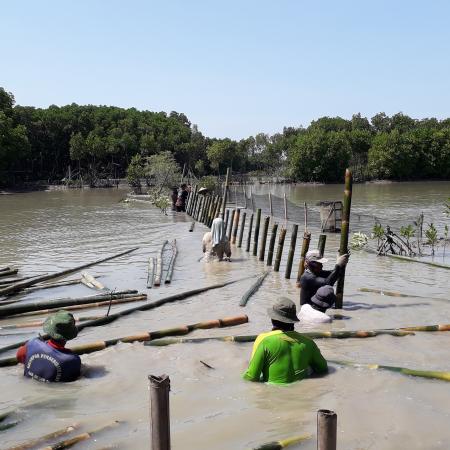
L'AMA et l'IMTA ont changé les moyens de subsistance de la famille
Depuis 2000, pak Abdul Kohar n'a pas stocké de crevettes ou de poissons laitiers dans son étang de 2 hectares. Au cours du deuxième mois suivant l'ensemencement des crevettes, la plupart d'entre elles sont mortes, tandis que d'autres ont été perdues lors des marées de printemps. Il a donc récolté les fruits de mer sauvages qui se sont retrouvés piégés dans son étang et dans les pièges de la porte à la pleine lune. En 2017, le projet Building with Nature Indonesia a proposé au groupe du village d'appliquer l'AMA dans les étangs adjacents aux rivières. L'emplacement de son étang correspondait aux critères, et il a construit la digue et les portes supplémentaires en utilisant l'argent du mécanisme de bio-droits. En 2018, il a commencé à vider quotidiennement les pièges de ses vannes. Les résultats l'ont rendu très heureux : outre les poissons, tels que le mulet et le vivaneau, il a attrapé des crevettes tigrées (Penaeus monodon) et des crevettes blanches (P. merguensis), deux espèces qu'il n'avait pratiquement jamais pêchées au cours des dernières années. Cela a amené Kohar à penser que son étang pourrait être réutilisé pour la culture.
En 2017, l'UNDIP-FPIK-Aquaculture a également cherché des agriculteurs prêts à piloter l'AMTI. Dans cette AMTI, des crevettes, des poissons-lait, des algues, des coques et une cage avec des tilapias sont combinés pour tirer parti de tous les nutriments présents dans l'eau. Pak Kohar a essayé de cultiver ensemble des crevettes tigrées, des poissons-lait, des palourdes et des algues. Au cours du premier cycle, les crevettes ne sont pas mortes ; au cours du troisième mois, il a récolté 50 kg de crevettes tigrées et 500 kg de palourdes, dont il avait initialement stocké 200 kg. En outre, la récolte de poissons-lait, qui n'était que de 200 kg avant 2000, a atteint 600 kg.
Pak Kohar a également réussi à cultiver des algues et à produire un volume suffisant pour intéresser les acheteurs de l'usine. Plus tard, il a proposé à plusieurs autres agriculteurs d'ajouter des algues à leur bassin à crevettes. Ce premier succès a encouragé Kohar à gérer son étang plus sérieusement. Après avoir préparé l'étang, il a ajouté le tilapia à ses autres cultures. La deuxième année a été encore plus fructueuse : Les rendements ont doublé pour les crevettes et le poisson-lait, et triplé pour les palourdes. En outre, les prises quotidiennes dans ses pièges ont augmenté à la fois en volume et en variation. Il a également capturé des crabes bleus, dont le prix de vente est élevé.
Ce succès global a donné à Kohar le capital nécessaire pour améliorer son autre étang. Kohar applique également l'AMA, l'IMTA et les autres connaissances acquises dans le cadre de l'AFS. Avec l'argent restant, il a acheté une nouvelle moto pour le transport quotidien de sa petite famille.
